Welding robot
Robotic welding reinvented
___________
Does your company's business revolve around welding? If so, you probably operate one or more welding stations.
We have to admit that welders are becoming scarce these days. The loss of the know-how of experienced welders is a very real threat and new recruits are not rushing to the door.
But, good news! Automation is just around the corner and it is now possible and even desirable to solve some productivity and labor issues with collaborative robots.
What is the automation of welding tasks?
In simple terms, it's basicallya workstation orcell equipped with a robot handling welding equipment - in this case, a torch and filler metal, if applicable. Of course, some types of welding lend themselves better to automation, and that's what we'll be discussing here.
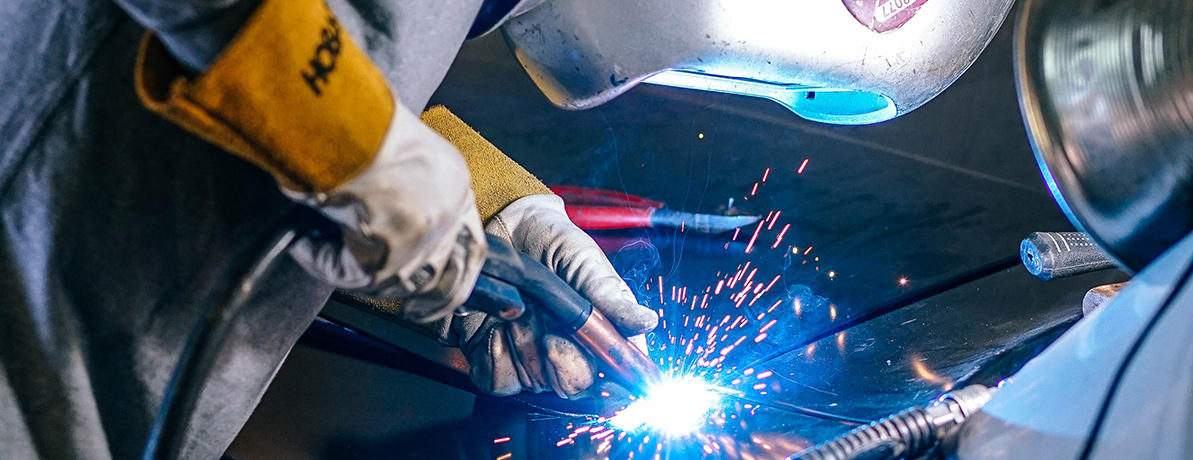
On the other hand, a robotized welding cell is equipped with a welding machine, a jig for holding the workpieces in place, arc flash protection equipment and solutions for welding fume extraction.
Need help with your welding automation project?
Why automate welding?
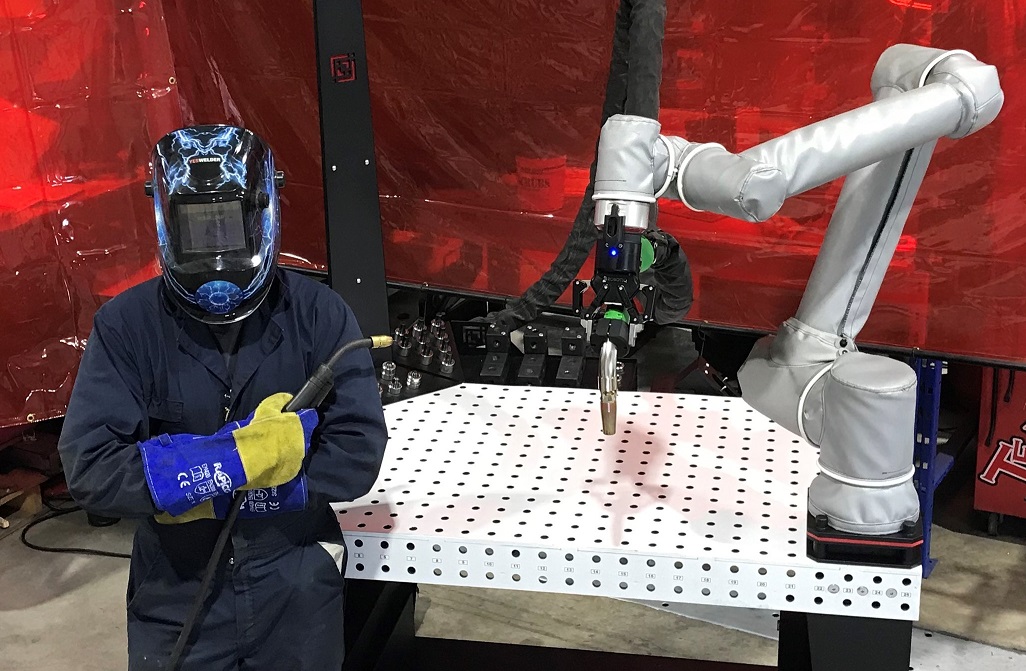
Techjig's collaborative welding robot with its operator.
What are the reasons that motivate manufacturing companies to automate one or more welding processes?processes?
We find in the running the possible productivity gains as well as the great evil of the early 21st century, the shortage of labour - welders are no exception, especially as their population is aging. Alternatively, one can also think of the benefits of moving to automation:
- repeatability and consistency of welds,
- low waste of fuse electrodes (consumables),
- little reprocessing and reworking,
- rapid arrival of processed units on the market.
Given the obvious ease of programming and operating collaborative robots, it is now possible to automate both high-volume, low-mix and low-volume,high-mix production cells.
For example, there are various components of a robotic welding cell that facilitate the automation of traditionally complex processes that could not be accomplished without direct and continuous human intervention. One example is automatic seam tracking, which is made possible by advanced vision systems. This is a rather laborious solution, but still feasible.
As with any robotic cell integration, the key is simplicity - the primary goal is to implement a basic working cell with proven and accurate production models, and use it as an example to tackle tricky processes. It's better to flesh out a simple cell that works than to deploy too many resources (sometimes in vain!) to get a complex cell right the first time.
Characteristics of the Robotic Welding Cell According to the Process to be Automated
When talking about a collaborative welding robot rather than an industrial one, the type, positioning, features and specifications of each component must be carefully considered:
Main types of welding machines;
-
- Metal Inert Gas (MIG) welding) - filler metal in the form of a fusible electrode (consumable); the robot manipulates the torch, in which the coated electrode and the inert gas are housed;
- Metal Inert Gas (MIG) welding) - filler metal in the form of a fusible electrode (consumable); the robot manipulates the torch, in which the coated electrode and the inert gas are housed;
-
- Tungsten Inert Gas (TIG) welding - filler metal in the form of an infusible rod (non-consumable); the robot handles the torch and an auxiliary support for the filler metal and the inert gas;
-
- Laser welding - a recent technology that can be easily robotized, which consists of heating the base metal and generally does not require a filler metal, but still requires the presence of a barrier gas - allows narrow and deep welds to be made quickly.
Robot range in relation to the worker and the part to be processed.
Access to spare consumable units (coated electrodes, flux-cored wire, solid wire, etc.)
Access to base metal and work surface preparation equipment.
Choice of an adequate work surface and holding device for the parts to be treated.
Positioning and orientation of components (entry point, exit point, work table, worker, robot, spare units, etc.)
Safety equipment and smoke extraction device.
How to choose the right equipment and components?
First of all, depending on the space, human resources and financial means at your disposal, do you plan to integrate an industrial robot or a collaborative robot? Generally, industrial cells take up a lot of floor space, are very expensive and rigid, and are suitable for the rapid processing of a very large number of identical parts (high-volume, low-mix). On the other hand, the collaborative cells are highly adaptable, require little investment and occupy little floor space. What's more, their safety devices are easily configurable.
But if the ultimate goal is to retain the workforce and empower them to perform high-value tasks, the implementation of collaborative cells is probably the best way to do that.
Then, after having established your needs and the criteria of the process to be automated (please refer to the section "Cell characteristics according to the process to be automated"), you will have a very good idea of what you need: a custom solution or a pre-assembled system.
Manufacturers and suppliers of pre-assembled systems generally provide buyers with reliable documentation of their component specifications, which facilitates decision-making.
The cost of integrating the cell should not be overlooked. The total investment can vary greatly depending on whether or not you have relevant robotics expertise in-house.
In general, the acquisition of a collaborative collaborative robot represents an investment of about 40 000$ à 70 000$but this is a price range to be taken with a grain of salt.
The most important point for the buyer is to distinguish the distinction between the price of the cobot and the price of the entire robot cell.
It all depends on the complexity of the project, the necessary redevelopment, the resources deployed in integration and the process to be automated, the total cost can vary between $150,000 and $250,000.
In comparison, the integration of industrial robots is about 10 times more expensive.
The advantages of Techjig's TACKTIC welding solution

Easy to integrate on your floor.
Small footprint.
Simplified cell security.
Increased human-machine collaboration.

From box to production in 45 minutes.
An easy to program interface for everyone.
Do it yourself and start welding right away.

Compatible with a multitude of welding machines.
Use your welder or the one that suits you best.
Reduce the cost of acquisition.
Reduce learning time

Reduce downtime with a robot that does more.
Load, unload, place, position, validate, control and more.

Change production in minutes.
A flexible solution that meets your needs for both high and low volume.

Innovative technology.
Industry-leading products combined with patent-pending technology from Techjig Inc.
Need a helping hand to get started?
At Pneumac Automationwe have an in-depth knowledge of robots Universal Robots (UR) and the solutions Techjig solutions and have a strong confidence in these brands.

First of all, UR cobots are the most widely used in the world, and for good reason! UR makes theUR+ ecosystemecosystem, a pool of robot components and end-effectors supplied by third-party companies. UR puts each manufacturer through a rigorous process of testing, documentation validation, quality control and safety certification before including them in the UR+ ecosystem.
For this reason, we recommend the integration of robots with intermediate or long reach, specific to welding contexts. Speed and payload are of little importance in this case.
Collaborative Robot UR10e
Universal Robots
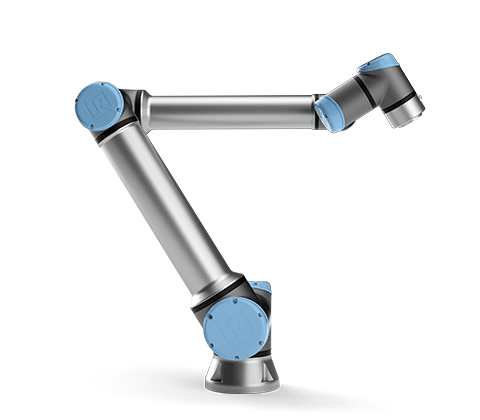
The UR10e is an extraordinarily versatile collaborative robot, offering both a high load capacity (12.5 kg) and a long reach (1300 mm).
UR20 Collaborative Robot
Universal Robots
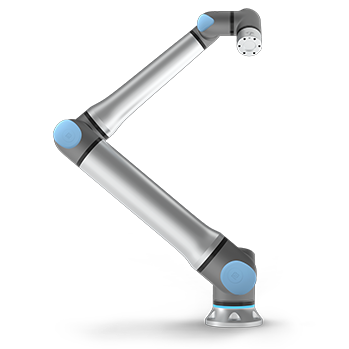
With a reach of 1750 mm and a payload capacity of 20 kg, the new generation UR cobot handles more tasks and adapts to more applications.
Techjig's software components and products are incredibly adaptable and can meet most requirements with a small, sustainable investment. One example is the solution Tacktic™ and the WeldCreator™.
The solution Tacktic™ welding solution is a pre-integrated collaborative robotic cell that offers the manufacturer the efficiency of a collaborative robot without compromising on flexibility and ease of implementation. The Tacktic™ solution is the only product on the market to offer Techjig Inc.'s patented technology that allows the robot to do much more than just weld. It allows the robot to load and unload parts, open toggle clamps, clean welds, validate part dimensions, position sub-assemblies and much more with the help of the gripper. Make the most of your investment with a more autonomous cell.
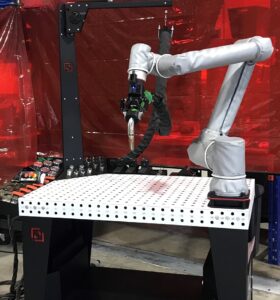

Techjig's Welding URCap allows you to speed up the programming of your parts. Make welds in less than 2 minutes. Simplify complex operations with the help of numerous functions: torch oscillation, step welding and more. Compatible with all models of welding machines.
Would you like to know more?
Address
100 Goyer Street, room 103
La Prairie (QC)
J5R 5G5
Phone
514.745.1987
1.800.361.1684
info@pneumac.qc.ca
